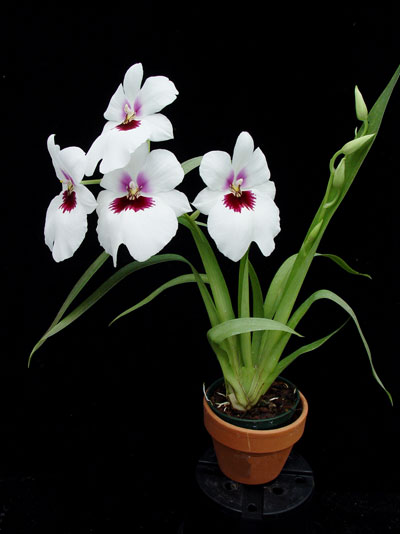Light and Shade
We have found that Miltoniopsis grow well under a rather low amount of light (1500 to 2000 foot-candles), so that if a hand is passed over the leaves it does not produce a shadow. We recommend growing in east or west-facing windows. South-facing windows should only be used if shielded from the sun using a sheer curtain. If temperature highs remain below these orchid's limits, then Miltoniopsis can be grown outside from June to late fall in areas with filtered light, such as through a pine tree or shrub in early morning or afternoon. Be careful not to exposure these orchids to prolonged direct sunlight, as the leaves will sunburn easily. If using artificial light to grow indoors, LEDs are the best option for Miltoniopsis. The artificial light market has expanded greatly in recent years, so a quick Google search will result in a variety of lighting options and price ranges.
Temperature and Humidity
Miltoniopsis do well in the average home or intermediate temperature greenhouse. These orchids prefer daytime temperatures from 70°F to 80°F (21°C to 27°C), and night temperature between 55°F to 65°F (13°C to 18°C). They will tolerate higher or lower temperatures, but not for extended periods of time. If you keep your Miltoniopsis watered well, humidity will not be a critical factor in their growth. However, Miltoniopsis thrive under high humidity and will benefit from humidity levels above 50%. This can be achieved at home with the use of a humidifier or a humidity tray. Just make sure that the plant is not standing in water or the roots will rot.
Watering
Miltoniopsis like to be kept fairly moist, with the media becoming only slightly damp between waterings. During warm dry weather, they may need to be watered 2 to 3 times a week. These orchids form wrinkled, accordion-like pleated leaves when not receiving enough water. If this happens, check the root system. Over-watering may have caused the roots to rot, thereby depriving the plant from absorbing water. If the roots are healthy, you are likely under-watering and should increase your watering schedule accordingly.
We always recommend watering in the morning, as this gives the leaves time to dry and avoid bacterial growth overnight. If possible, use water low in alkalinity, such as rainwater, distilled water, or reverse osmosis water. If you have a dehumidifier in your home, the water that collects in the tray is excellent for watering orchids.
Feeding
We highly recommend Green Jungle Orchid Food, specially formulated to provide orchids with the nutrients they would naturally encounter in their wild habitats. This is the fertilizer that we developed to use on our own plants in production, with excellent results for decades! This formula works best with water low in alkalinity (such as rainwater, distilled water, or reverse osmosis water). However, you may use tap water, keeping in mind that mineral buildup will require repotting more frequently, on the order of every 1 to 2 years.
If potting in bark mix, fertilize every time you water, flushing with non-softened water once a month. This rinses the media of salt and mineral buildup. When potting in sphagnum moss, fertilize every 3rd watering year round.
Potting
Miltoniopsis do well in a light, porous medium, capable of holding moisture while draining thoroughly upon watering. At Orchids Limited, we recommend potting these plants in New Zealand Sphagnum Moss or the Medium grade of our Traditional Orchid Bark Mix.
These orchids like to be somewhat pot-bound, so allow room for only one year's new growth. Repot once per each year, preferably in the spring when active growth resumes. When repotting, choose a pot that is large enough to accommodate 1 or 2 years growth (2 to 3 new bulbs per year). Grab the plant near the base of the pot and start by gently, but firmly, pulling the plant out of its old pot. If the mix is old, crumbly and sour, carefully remove the media and rinse the root system. Trim off any dead roots and dead bulbs. Position the plant with its oldest bulbs to the edge of the new pot. Then, spreading the plant roots out, fill in the space with the potting medium.
Should you wish to divide your plant at this time, each section should have three or four green bulbs in addition to any new leads. Old leafless pseudobulbs should be removed if the procedure will cause no damage to the rest of the plant. You can watch our video on dividing orchids here.
To avoid the transfer of orchid diseases, it is standard procedure to sterilize all cutting and potting instruments before using them on a plant. This can be done by flaming pruning shears with a butane torch, or by spraying with rubbing alcohol and wiping with a clean paper towel.
Pest Control
These orchids can attract spider mites in the summer, and slugs in the winter. To avoid getting mites, take the plant into the shower once a month and spray the foliage lightly with room temperature water. If you have spider mites, insecticidal soap sprayed 3 times, one week apart, should control them. To control for slugs, maintain a small sprinkling of slug bait over the months during winter months.

